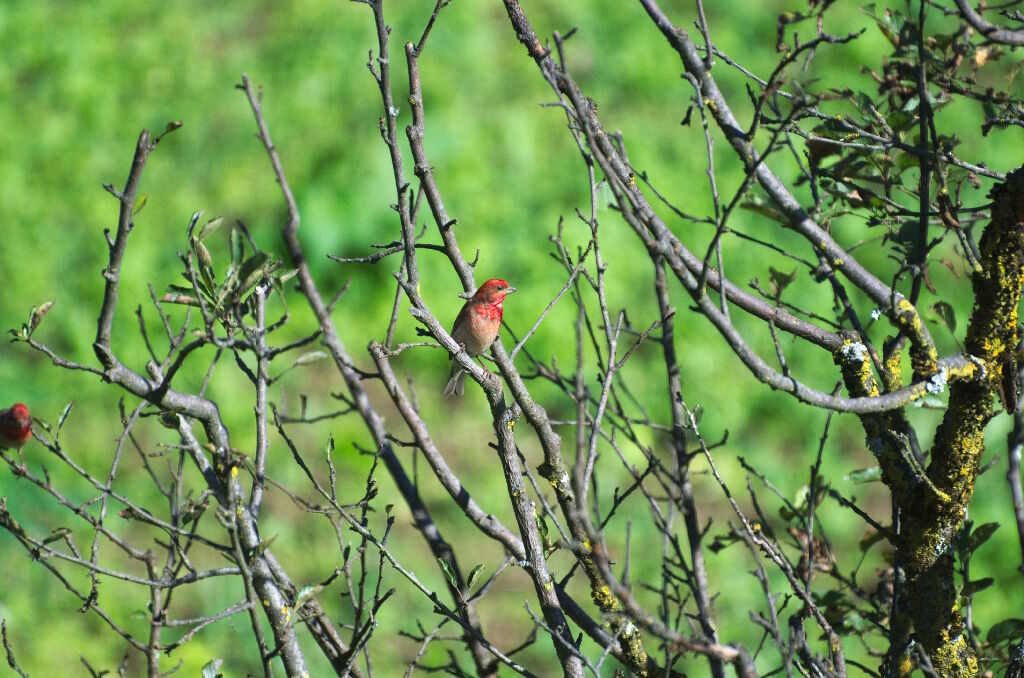
Carpodacus erythrinus (Common rosefinch)
Carpodacus erythrinus, commonly known as the Common Rosefinch, is a colorful and melodious bird often seen in the Great Himalayan National Park (GHNP). Recognizable by the male’s vibrant rose-red plumage and the female’s warm brown tones, Carpodacus erythrinus is a seasonal visitor that enhances GHNP’s biodiversity during the warmer months. Its lively song and striking appearance make it a favorite among birdwatchers exploring the alpine and subalpine regions of the park.
Observing the Common Rosefinch in its natural Himalayan habitat is a rewarding experience for wildlife enthusiasts visiting GHNP.
Habitat and Distribution in GHNP
In the Great Himalayan National Park, Carpodacus erythrinus typically inhabits open forests, scrubby hillsides, and river valleys between 1,500 and 3,500 meters elevation. It favors areas with dense shrubs, willow thickets, and scattered trees near water sources, making places like the Sainj and Tirthan valleys ideal for sightings.
The Common Rosefinch is migratory, arriving in GHNP during the spring and summer for breeding and retreating to lower elevations or southern regions in the winter months.
Behavior and Diet
Carpodacus erythrinus feeds mainly on seeds, berries, and buds, supplemented by insects during the breeding season. Its diet plays a vital role in seed dispersal, aiding the regeneration of vegetation within the park’s diverse ecosystems.
The male’s cheerful, warbling song is often heard from exposed perches, especially during the breeding season when it sings to attract mates. Nests are usually hidden low in thick bushes, carefully woven from grasses and plant fibers.
The Common Rosefinch is relatively shy compared to other Himalayan finches, often retreating into dense vegetation when approached.
Conservation Significance
Currently listed as a species of Least Concern, Carpodacus erythrinus benefits greatly from GHNP’s protected habitats. Continued conservation efforts to preserve the park’s riverine forests and scrublands are essential for supporting this and many other migratory bird species.
Monitoring the Common Rosefinch populations within GHNP offers insights into the broader impacts of climate change on Himalayan bird migration and breeding patterns.
| Common name | Common Rosefinch |
| Scientific name | Carpodacus erythrinus |
| Family | Fringillinae |
| Description | Both in the rose coloured male and the brownish female the heavy conical finch bill and the slightly forked tail are noticeable features. Flocks, in wooded country and about cultivation. It keeps in flocks to wooded country, feeding on lantana and other berries, wild figs flower buds, bamboo seed, linseed and cereals. Flower nectar Butea, Erythrina and other flowers is also relished, and the birds do serve in cross-pollinating them. Ordinary call note: a musical whistling, interrogative tooee? Tooee? Just before departure for breeding grounds a loud, pleasant song sometimes heard.Winter migrant and breeds at 3000m and higher in the Himalayas. Found south of the Himalayas. |
Conservation Significance
Currently listed as a species of Least Concern, Carpodacus erythrinus benefits greatly from GHNP’s protected habitats. Continued conservation efforts to preserve the park’s riverine forests and scrublands are essential for supporting this and many other migratory bird species.
Monitoring the Common Rosefinch populations within GHNP offers insights into the broader impacts of climate change on Himalayan bird migration and breeding patterns.



